The host city
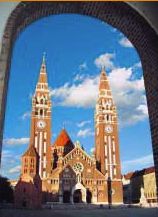 Szeged is situated near the Southern border of Hungary, on the banks
of the River Tisza. A large part of the town lies on the right bank,
while Újszeged, a leafy residential district, lies on the left
bank of the river. Szeged is the cultural and economic hub of Southeastern
Hungary, and a thriving university town famous for its open-air theatre.
The city centre is marked by the medieval Tower of St. Demetrius and
the stately twin spires of the Roman Catholic Cathedral (Dóm).
This cathedral was built in the first decades of the 20th century to
commemorate the rebirth of the city after the devastating flood of the
Tisza in 1879.
Szeged is situated near the Southern border of Hungary, on the banks
of the River Tisza. A large part of the town lies on the right bank,
while Újszeged, a leafy residential district, lies on the left
bank of the river. Szeged is the cultural and economic hub of Southeastern
Hungary, and a thriving university town famous for its open-air theatre.
The city centre is marked by the medieval Tower of St. Demetrius and
the stately twin spires of the Roman Catholic Cathedral (Dóm).
This cathedral was built in the first decades of the 20th century to
commemorate the rebirth of the city after the devastating flood of the
Tisza in 1879.
By Hungarian standards, Szeged is a large city with its population of 180,000. The climate is highly favourable. The mean temperature is 11! C (52! F), somewhat higher than in the rest of the country. Szeged is sometimes called the City of Sunshine as it enjoys an average of 2,000 hours of sunshine annually.
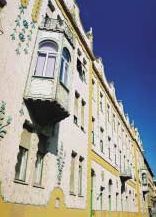 The region around Szeged has been inhabited since Roman times. During the period of the Great Migration from the fifth to the ninth centuries, it was a meeting place for various tribes. The region is therefore abundant in valuable archaeological sites.
The region around Szeged has been inhabited since Roman times. During the period of the Great Migration from the fifth to the ninth centuries, it was a meeting place for various tribes. The region is therefore abundant in valuable archaeological sites.
The settlement was given the rank of a free royal town in 1241; it was an important monastic centre in the Late Middle Ages; during the 16th and 17th Centuries it was occupied by the Turks and served as an administrative centre.
The great flood of 1879, mentioned earlier, turned out to be a blessing in disguise. The reconstruction that followed - through the help of Vienna, Paris, London, and other European cities - created a modern city with an exemplary layout of avenues and boulevards and a strikingly homogenous architecture that preserves the Eclectic and Art Nouveau styles from the turn of the century.
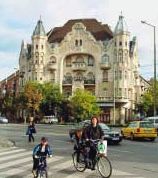 Szeged is
the economic centre of the region and is famous for food processing,
especially salami and paprika. Textiles, clothing and natural gas are
also significant, but the city is most famous for its culture, including
its university.
Szeged is
the economic centre of the region and is famous for food processing,
especially salami and paprika. Textiles, clothing and natural gas are
also significant, but the city is most famous for its culture, including
its university.
In spite of the fact that Szeged has the atmosphere of a quiet college town, the city is surprisingly cosmopolitan. The UNESCO-sponsored international Centre for Biological Research of the Hungarian Academy of Sciences, as well as other institutions of higher education, host a large number of international scholars and students. The local opera is second in reputation only to the one in Budapest. Theatres, cinemas, clubs, the riverbanks, parks, swimming pools and sports grounds provide a variety of venues for recreation.
The Southern Great Plain - Sights in the Region
The Southern Great Plain encompasses three administrative areas: the counties of Bács-Kiskun, Békés and Csongrád. The region lies in the heart of the Carpathian Basin; in the town of Szarvas there is even a monument which marks its exact geographical centre. The region is famous for its national parks (e.g. Kiskunság, Körös-Maros) as well as for its thermal baths. Cultural events are held throughout the year: among the many offerings are the Szeged Open-Air Festival, the Gyula Castle Tournament and the Famous Festival in Kecskemét.
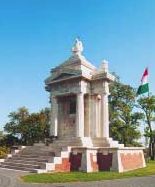
Ópusztaszer offers a National Memorial Park
and the second largest cyclorama in the world, the Feszty
Cyclorama, which was painted on 1800 square metres of canvas and is housed
in a huge round hall built just for that purpose. The central scene of the
painting depicts the ninth-century Hungarian chieftains witnessing the victorious
charge of the Hungarians into the Carpathian Basin.
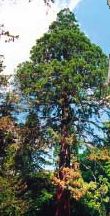
Szarvas boasts a botanical garden where you can find about 1600 types of various shrubs, trees and fungi from all over the world. The garden also provides a habitat for about a hundred species of birds.
The Kiskunság National Park abounds with magnificent photo opportunities with its sandy woods, sunflowers and vineyards. The lovely farms, csárda-inns and stables also add to the charm of the region. It is the Kiskunság where the most aromatic apricot is grown for Hungary’s famous apricot brandy.
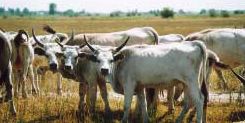
The Bugac Plain is one of the most popular areas in he country, where traditional methods of raising cattle have been preserved to this day. The region is also famous for the Hungarian Plain Five - a feat of fine horsemanship.
Kiskunhalas is famous for its lace house which boasts an exhibition of lace from all over the world. In Kiskunhalas lace is made form the world's thinnest flax yarn. Apart from the usual motifs, events and personalities from Hungarian history are also depicted.
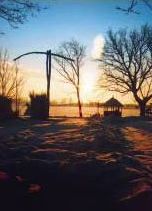 Makó onions
are famous throughout the country for their bright red skins and ivory
flesh. They are grown in a two-year production cycle and are stored in
special onion driers. You can even see them as decoration in people's
homes. So key is the onion to the local economy that the people of the
town have even erected a monument to it, as well as naming a theatre
and a festival after it.
Makó onions
are famous throughout the country for their bright red skins and ivory
flesh. They are grown in a two-year production cycle and are stored in
special onion driers. You can even see them as decoration in people's
homes. So key is the onion to the local economy that the people of the
town have even erected a monument to it, as well as naming a theatre
and a festival after it.
Gyula isn’t only famous for its characteristically seasoned smoked sausages, but also for the most complete medieval castle to survive in Hungary. The excellent medicinal waters have earned the castle baths an international reputation.
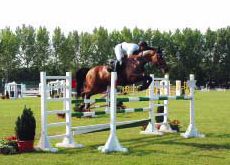 Mezõhegyes is famous for its stud farm and agricultural buildings. Originally the state stud farm was founded for military purposes by Joseph II, emperor of Austria-Hungary.
Mezõhegyes is famous for its stud farm and agricultural buildings. Originally the state stud farm was founded for military purposes by Joseph II, emperor of Austria-Hungary.
Békéscsaba is the site of the biggest Lutheran church in the country, where concerts are often held. There is also a house dedicated to Mihály Munkácsy, the most famous 19th-century Hungarian realist painter.
In Szabadkígyós you can find a Neo-Renaissance/ Eclectic palace once owned by the wealthy Wenckheim family. The palace is surrounded by a French garden with a fountain.
 Kalocsa, the thousand-year-old cathedral town, is famous for its special type of embroidery handed down from generation to generation. The motifs used are richly colourful and diverse. Kalocsa is also home to a Paprika Museum. The traditions of Kalocsa paprika date back to Turkish times when it was secretly grown for medical purposes.
Kalocsa, the thousand-year-old cathedral town, is famous for its special type of embroidery handed down from generation to generation. The motifs used are richly colourful and diverse. Kalocsa is also home to a Paprika Museum. The traditions of Kalocsa paprika date back to Turkish times when it was secretly grown for medical purposes.